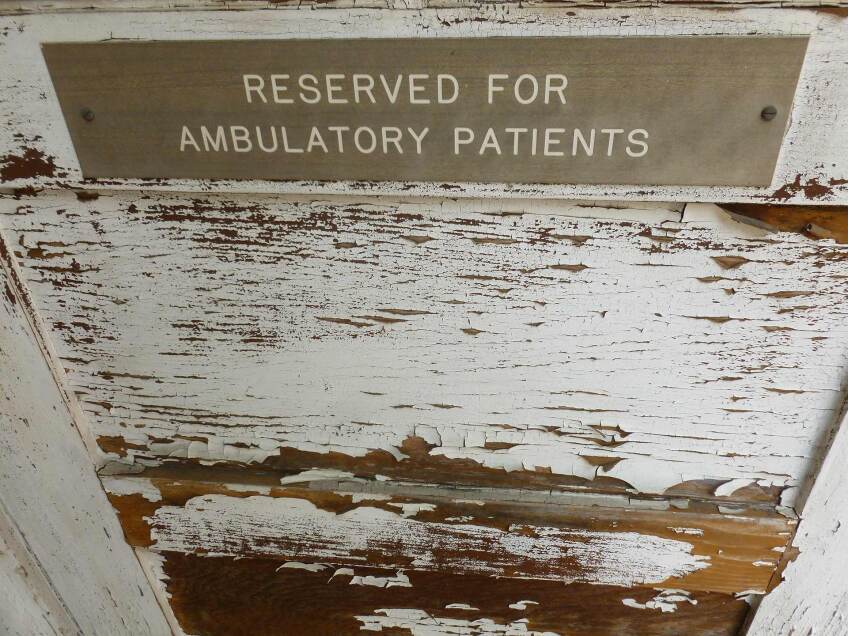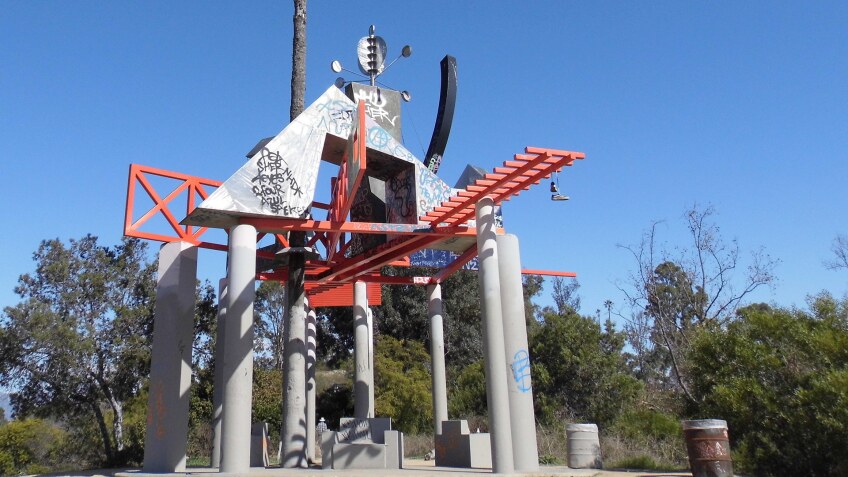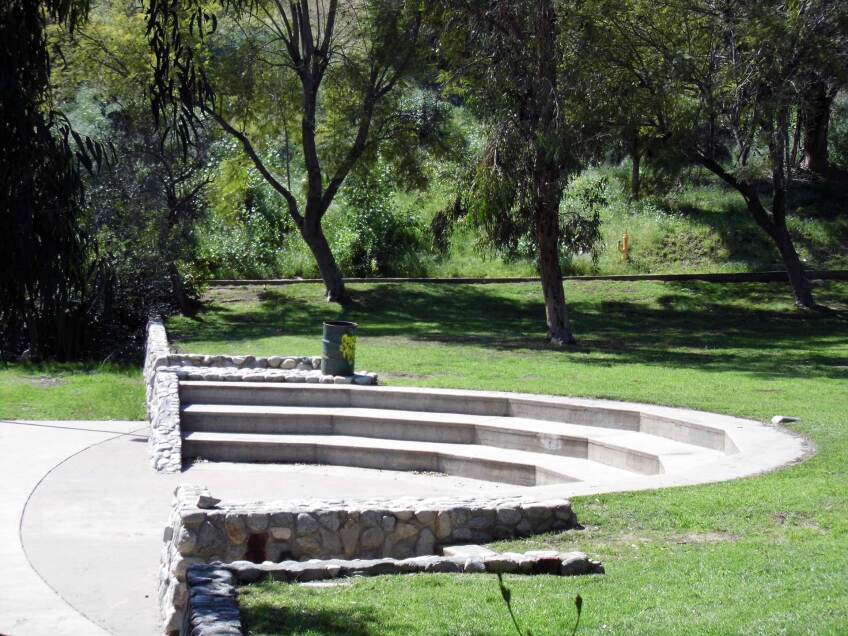How to Discover the Wonders of Elysian Park by Car

Editor's note: This article has been updated to reflect the status of the current buildings at Barlow Hospital and clarify photo captions in that section.
Elysian Park is one of the most misunderstood and underestimated green spaces in the City of Los Angeles. Too many people only ever talk about it — or visit it — because of Dodger Stadium.
But at approximately 600 acres, this is the second-largest municipal park in L.A. (second only to Griffith Park). And it’s got a lot more to offer than “Dodgertown.”
This “playground of the Angels” gets its name from Elysium (or Elysian Fields), where according to Greek mythology, the souls of heroes ascend in the afterlife. The parkland was originally set aside in 1883, but it didn’t actually become Elysian Park until 1886.
Situated between the L.A. River (and the densely populated communities adjacent to it), Chinatown, downtown Los Angeles, Angelino Heights and Echo Park, this hilly land has been considered prime property starting maybe with the Portolá Expedition, which camped there in 1769, but the expedition passed through it and moved along to its next destination.
The park’s original charter protects its semi-wild character forever. However, since its inception, developers and other private interests have tried to exploit and transform the park’s natural beauty for their own gain. Proposed park “enhancements” — or erosions to the open space — have included two football stadium proposals, a small airport, oil wells for Occidental Petroleum, an Asian trade center, several condo projects, a zipline, a child-care facility, etc.
Fortunately, none of those have happened. But the park isn’t as pristine as it was upon its creation.
Some of the land uses in Elysian Park that aren’t focused on its natural character have become historical points of interest in their own right, offering unique and significant architecture, art, cultural impact and even a bit of Hollywood history.
You may already know Elysian Park for its trails, its overlooks or even its secret swing— but how many of these “hiding-in-plain-sight” attractions have caught your eye?
1. LAPD Police Academy


The Los Angeles Police Academy is one of the most recognizable landmarks of Elysian Park — though the parcel of land it currently stands on was previously used as a pistol range for the Los Angeles Police Revolver and Athletic Club (formed in 1925 as a private organization of sworn members of the Department) and as a setting for the pistol and rifle competitions in the 1932 Olympic Games (including the shooting part of the modern pentathlon event). At the time, cadets and new officers were training at the nearby armory (see #2 below) — and before that, the only training they received was on the job!
Much of the academy campus was built using salvaged street lamps from the Bureau of Street Services, as well as lava rocks, bricks and other building materials scrapped from businesses gone belly-up during the Depression. You’ll see its handiwork in the Academy Arches, which have appeared in many TV and movie productions, including “American Beauty,” episodes of “Dragnet” and “T.J. Hooker.” They’re easily visible without even having to pass through security (which you can do on foot when the Academy Café reopens for dining).
The Academy’s first class graduated in 1936 and since that time, notable graduates have included former Los Angeles mayor Tom Bradley, who rose to the rank of Lieutenant, the highest rank for a black LAPD officer at the time; and Star Trek creator Gene Rodenberry, who became a sergeant in 1953 and resigned from the force in 1956 for a full-time Hollywood career.
1880 Academy Dr, Los Angeles, CA 90012
2. Frank Hotchkin Memorial Training Facility (Former Naval and Marine Corps Reserve Training Center)

Elysian Park’s Art Deco monolith by renowned architect Stiles O. Clements — which was built to look like a ship — has been used as a firefighters’ training facility and drill tower since the Los Angeles Fire Department first leased it from the Navy in 1994. It is named the Frank Hotchkin Memorial Training Facility in memory of a member of the LAFD who was killed in 1980 while fighting a fire there that caused $500,000 in damages to the center. At that point, it was known as the Naval and Marine Reserve Armory.
Completed as part of the Works Progress Administration in 1940 on land donated to the Navy by the City of Los Angeles, it was one of the largest naval reserve armories in the U.S. and the country’s second Navy Reserve Center to be built. Elysian Park was a choice location for it, with two strategic advantages: a full view of downtown Los Angeles and the concealment provided by the rugged terrain. Used to train over 100,000 sailors since its completion — including such famous reservists as Douglas Fairbanks Jr. and John Ford — the armory originally had a rifle range, indoor pool, living quarters for visiting admirals and a banquet room and bar (much of which was destroyed in the fire).
In 1989, the monumental structure was designated California Historic Landmark #972 after a six-year, $4.5-million renovation that reopened the facility in 1986. The U.S. Armed Forces permanently ended operations there in 1995 and in 1998, the property was determined to be surplus. Opportunities for the public to visit are rare aside from occasional 9/11 memorial services and community open houses, but it is surely a sight to behold even just from the street. Access may be temporarily limited while it’s being used as a COVID-19 testing site for first responders, but aspiring firefighters should keep an eye out for when it offers the biannual Youth F.I.R.E. (Fire Instruction Recruitment & Education) Program to 14 to 18-year-olds.
1700 Stadium Way, Los Angeles, CA 90012
3. Barlow Respiratory Hospital (Former Barlow Sanatorium)




Barlow is and always has been a specialty hospital, opening first to treat patients befallen with tuberculosis. In recovery himself from the disease, founder Dr. Walter Jarvis Barlow built the Barlow Sanatorium in 1902 where the surrounding hillsides seemed to trap the clean air in the meadow — making conditions ideal for TB patients.
Although the Barlow Sanatorium was crucial in L.A.’s fight against the 1918-19 flu epidemic, the hospital shifted its focus to chronic respiratory issues by the 1960s.
The site is Los Angeles Historic-Cultural Monument #504, designated in 1990.
2000 Stadium Way and 1300 Scott Avenue Los Angeles, CA 90026
4. 'Frank Glass and Grace E. Simons Memorial Sculpture'



With its heavenly views, the scenic hilltop of Angel’s Point is home to the "Frank Glass and Grace E. Simons Memorial Sculpture" — a 28-foot-tall public art installation created by Echo Park-born and -based artist Peter Shire and dedicated in 1994 as a part of the Department of Cultural Affairs’ permanent art collection. It depicts a kind of mini city in sculptural form including oil wells, bungalows, freeways and even a man, all against the backdrop of the downtown L.A. skyline.
Simons co-founded the Citizens Committee to Save Elysian Park to spare the open space from being taken over by a convention center in 1965. Her husband and partner-in-activism — and the sculpture’s other namesake, Frank Glass — left money earmarked for such a memorial to the City of Los Angeles Department of Recreation and Parks upon his death in 1987, two years after she passed away at Barlow Hospital.
From the vantage point of the sculpture, take in the amazing views of Dodger Stadium, downtown Los Angeles and even the Hollywood sign and spare a moment to reflect on what the natural surroundings might’ve been like were it not for the efforts of Simons and her fellow conservationists.
Angel's Point, Elysian Park Dr, Los Angeles, CA 90012. Off Angels Point Road, above Lower Angels Point.
5. Montecillo de Leo Politi Park


Montecillo de Leo Politi Park is devoted to the memory of Leo Politi, a Fresno-born artist and author who was trained in Italy and made his mark on Los Angeles by residing as one of the last holdouts on Bunker Hill, working as “The Artist of Olvera Street,” and contributing a number of local murals and publications that celebrated the ethnic diversity of the area. Born Atiglio Leoni Politi, he often focused on children and children’s books and illustrations in his work — earning him another nickname: the Italian Dr. Seuss.
In his honor, Sunset Boulevard and Echo Park Avenue was renamed Leo Politi Square in 2008, upon the 100th anniversary of his birth. The Leo Politi tree stands across from the Biscailuz Building at Olvera Street, where his 1978 mural “The Blessing of the Animals” can also be seen. Leo Politi Elementary School is near the intersection of Olympic and Hoover in the Pico-Union district of Los Angeles. This hillside canyon picnic area was dedicated to Politi in 1994, two years prior to his passing at age 87.
Probably one of the most underused areas of Elysian Park, it’s the site of tennis courts and comfort stations constructed by the Works Progress Administration in 1936, as well as the former Recreation Lodge. Now sometimes referred to as the “Old Lodge” site, it once had an actual lodge building with kitchen facilities, available to rent by permit. The convention center proposal of 1965 (see #4 above) had the lodge and picnic area in its crosshairs, but thanks to the efforts of Grace E. Simons, that plan never came to fruition. However, an early 1980s fire that burned more than 300 acres consumed the lodge as well. With its rock-lined walls and amphitheater setting, Montecillo de Leo Politi is available for daily rentals (for a fee) by calling the Los Angeles Department of Recreation and Parks’ Metro Area Picnic Reservation line at (213) 485-5054.
Scott Road & Academy Road, Los Angeles, CA 90012. Recreation Lodge Drive off Stadium Way.
6. Chavez Ravine Arboretum



Declared Los Angeles Historical-Cultural Monument #48 in 1967, Chavez Ravine Arboretum was founded in 1863 by the Los Angeles Horticultural Society to transform 10 acres of Elysian Park’s western canyon into an exotic forest. Rare trees from around the world were planted here — somewhat haphazardly — through the 1920s. And perhaps miraculously, most of the originals are actually still standing. In fact, some of them, still growing today, remain the only living representatives of their species in Los Angeles. Many are the oldest and largest of their kind in the state of California — and, at 120 feet high, the Queensland kauri (Agathis robusta) is the tallest in the lower 48 states.
We’re talking about multiple varieties of eucalyptus, cypress, magnolia, cedar, oak, pepper, palm and fig trees — as well as, reportedly, even a giant Sequoia. Some specimens are thankfully labeled but many are not, making the online listing of species a necessary reference for those with a budding interest in arboriculture. One such unmarked tree is the Senegal date palm, a.k.a. African dwarf date palm (Phoenix reclinata), which was planted from seed imported from Africa’s Zambezi River region.
You’ll find the volunteer-maintained arboretum (SoCal’s oldest, pre-dating the Los Angeles County Arboretum in Arcadia by about 85 years) right around the corner from The Avenue of the Palms — a double row of Canary Island date palms (Phoenix canariensis) that was planted in 1895 on what’s now Stadium Way, between Scott Avenue and Academy Road. Many of those trees still tower over picnic areas, playgrounds, and parking spots, although a fatal fungus has struck some of them, necessitating some new plantings of Chilean wine palms (Jubaea chilensis), relative rarities in their own right.
929 Academy Rd, Los Angeles, CA 90012
Bonus: Elysian Park Adaptive Recreation Center
Although the Elysian Park Recreation Center’s programming is currently suspended and the building itself is closed to the public, it’s worth a visit to the exterior to pay your respects at the memorial rock and palo verde tree commemorating the President and Founder of Los Desterrados Former Residents of Chavez Ravine, Louis H. Santillan (or “Lou,” “Louie,” or “Big Lou,” as he was also known).
Los Desterrados means “The Uprooted” — so named because of how residents of three distinct neighborhoods, now collectively known as “Chavez Ravine” (Palo Verde, Loma, and Bishop), were either bought out or forcibly evicted in the 1950s. When Lou was 15 years old, for instance, his parents were given $7,500 for their two homes on what used to be Gabriel Avenue — approximately where third base of Dodger Stadium is now.
Since the group’s founding in 1983, the displaced residents and their families have met for an annual reunion in Elysian Park every third Saturday of July.
929 Academy Rd, Los Angeles, CA 90012
Top Image: Elysian Park's "Frank Glass and Grace E. Simons Memorial Sculpture" by Peter Shire | Sandi Hammerlein










